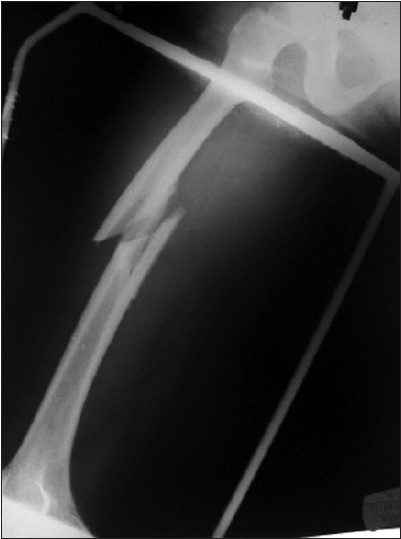|


 |
| LETTER TO EDITOR |
|
| Year : 2012 | Volume
: 4
| Issue : 2 | Page : 141-142 |
|
|
Management of Maternofetal Emergency in Shock with Fracture of Femur
Seema Rawat1, Sanjay Meena2
1 Department of Obstetrics and Gynaecology, Maulana Azad Medical College and Associated Lok Nayak Hospital, New Delhi, India
2 Department of Orthopaedics, All India Institute of Medical Sciences (AIIMS), New Delhi, India
| Date of Web Publication | 8-Apr-2013 |
Correspondence Address:
Sanjay Meena
Department of Orthopaedics, All India Institute of Medical Sciences (AIIMS), New Delhi
India
 Source of Support: None, Conflict of Interest: None
DOI: 10.4103/2006-8808.110269

How to cite this article:
Rawat S, Meena S. Management of Maternofetal Emergency in Shock with Fracture of Femur. J Surg Tech Case Report 2012;4:141-2 |
How to cite this URL:
Rawat S, Meena S. Management of Maternofetal Emergency in Shock with Fracture of Femur. J Surg Tech Case Report [serial online] 2012 [cited 2016 Jun 10];4:141-2. Available from: http://www.jstcr.org/text.asp?2012/4/2/141/110269 |
Sir,
We read with great interest, the manuscript by Singh et al. 'Management of maternofetal emergency in shock with fracture of femur'. [1] We must congratulate the authors for this case report and highlighting this uncommon issue. However, we would like to draw the attention of the authors and readers to the following:
- The authors did not mention the mechanism of injury and the time elapsed from injury to presentation. The mechanism of injury is an important aspect of the history that may suggest the fracture location, fracture configuration, and associated soft tissue injury. The time from injury to presentation gives valuable information regarding the potential for extensive blood loss into the thigh, the overall condition of the patient, and the possibility of significant associated soft tissue injury such as substantial muscle crush that is occasionally seen with a prolonged extrication
- Although isolated femur fractures are associated with blood loss requiring transfusion, their association with hypotensive shock is less clear. Ostrum et al. found that patients with femoral shaft fractures frequently exhibited hemodynamic changes with blood loss; however, hypotension was not observed. As a result, they recommended that in patients with an isolated closed femoral shaft fracture with associated hypotensive shock, alternative sources of blood loss should be investigated [2]
- According to the authors, the fracture was comminuted but [Figure 1] shows a simple oblique fracture. The pre-operative and post-operative radiograph shows different fracture patterns. It seems that the fracture was converted into a segmental pattern while being operated. No mention of it was made in the
- manuscript
- The fracture was at the level of the isthmus and was amenable to retrograde nailing. All fractures of the femoral shaft that are distal to the lesser trochanter are amenable to retrograde fixation. [3] In pregnant patients, retrograde nails may be easier to place and have the advantage of minimizing the amount of radiation exposure. In pregnant patients, osseous landmarks are difficult to palpate, and femoral adduction is usually somewhat limited. This frequently leads to the need for a large surgical approach to simply identify the osseous anatomy proximally. In addition, it also has the advantage of minimizing the amount of radiation exposure. There are plethora of articles available in the literature recommending retrograde nailing in pregnant patients with fracture shaft of femur.
 | Figure 1: Preoperative radiograph of the patient showing a simple oblique fracture of femur
Click here to view |
With warm regards, and once again, congratulations for the research.
 References References | |  |
| 1. | Singh PK, Shrivastva D, Paddalwar S, Shetty N, Raut V, Patnaik S, et al. Management of maternofetal emergency in shock with fracture of femur. J Surg Tech Case Rep 2011;3:52-5. 
|
| 2. | Ostrum RF, Verghese GB, Santner TJ. The lack of association between femoral shaft fractures and hypotensive shock. J Orthop Trauma 1993;7:338-42. 
|
| 3. | Leung KS, Taglang G, Schnettler R. Practice of intramedullary locked nails: New developments in techniques and applications. Springer: Berlin, Heidelberg; 2006. p. 117-25. 
|
[Figure 1]
|